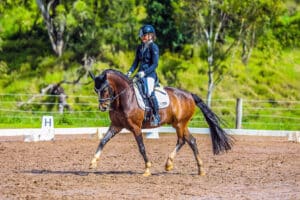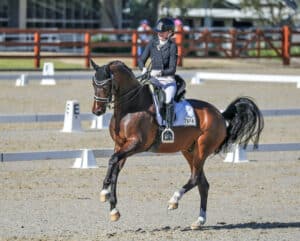Training under the discipline of accuracy
Dressage is all about details. NICOLE TOUGH explains how to gain a competitive edge and reduce the degree of subjectivity in your tests.
The sport of dressage is subjectively judged, with much of it out of our control, and many people feel that the quality of horse is the most important element. But the elements that we can control are the quality of our training and the accuracy with which we ride.
Improved levels of technical riding and attention to accuracy gives a competitive edge and riding accurately can win a class. The marks are weighted to the technical side. The degree of precision directly affects each mark, and will be positively assessed in the Submission and Rider collective marks at the end of a test.

Accuracy means performing all movements accurately to markers, on prescribed lines, with circles starting and finishing and transitions executed as the rider’s body passes the marker. Accuracy is being in control of where we are positioning our horse at all times.
An accurately ridden test presents a professional, competent picture to the dressage judge, and demonstrates that the horse is sufficiently supple and balanced to perform the exercises demanded in the test. In a nutshell, precision shows a greater degree of difficulty, and should be recognised by the judges and rewarded.
The rider that trains whimsically and thinks they will pay more attention to accuracy when they are actually in the competition arena, will find that not only will they surprise their horse with their new found attention to detail and leadership, but their minds will be unnecessarily swamped with extra noise concerning accuracy.

The need for accuracy will take up precious space in their minds that could be better served thinking about other things, like their position, the quality of the way of going, using corners and half-halts, preparing their horse for the movements and simply remembering where to go.
Accurate riding requires practise, and our goal is to present what we’ve practised. Riding accurate lines should be a good habit, the one thing we don’t have to think about when we compete. It should come as naturally as driving a car. Don’t train on aimless lines and execute transitions only when your horse is ready. Train to ride to checkpoints and on prescribed lines, and finish your movements before the corners.
Look up and ahead of you. If you are approaching the turn onto the centre line, turn your head and find ‘C’ before you start turning your horse. There is a saying: if you look where you’re going, you’ll probably get there. And it works.
Look for the next checkpoint on every circle to ensure its correct size and shape. As your head turns, so do your shoulders and hips, which only helps the horse to turn. The same can be said for corners; it is easy to be complacent about them. It is useful to think about corners as quarter circles. All we have to do is work out the best radius of a quarter circle our horse is capable of without losing their balance.
In every training session, once the warm-up is complete, train with technical correctness in all shapes, movements and transitions, even at the lowest level. This means practising square halts, hitting four checkpoints on circles, and executing transitions at certain markers instead of somewhere between them when the horse feels ready. By pre-determining the marker at which to execute the transition, we’ll be practising preparing towards a specific marker. Train the correct number of steps in the rein back, simple changes, and pirouettes. Pay close attention to these details.
This attention to training is not about repeating tricks or mistakes until we get it right, but rather training with a methodical mindset until we can’t get it wrong.
In the week leading up to an event, we should make ourselves practise the test. As we run through it, as soon as we lose any qualities circle off and re-establish the correct way of going, then return to the same line and resume practising the test. Repeat this method to the end of the test. The actual competition then becomes a familiar pattern that we have rehearsed and practised, and through which we can guide our horse.
It is a common thought that practising test lines will create anticipation and tension; and initially, when we start the repetition, there are degrees of this. Persevere. Continue to circle off and repeat, until we are past all anticipation. The best tests come when our horse knows their job, knows what they’re doing, knows what we are going to do, and waits for the signals. The best tests don’t come out of surprise, and besides, if we think our horses don’t know where ‘X’ is, we’ll be wrong every time.
The test that has been quietly perfected at home, under the discipline of accuracy, will always score better. This is the competitive edge.



